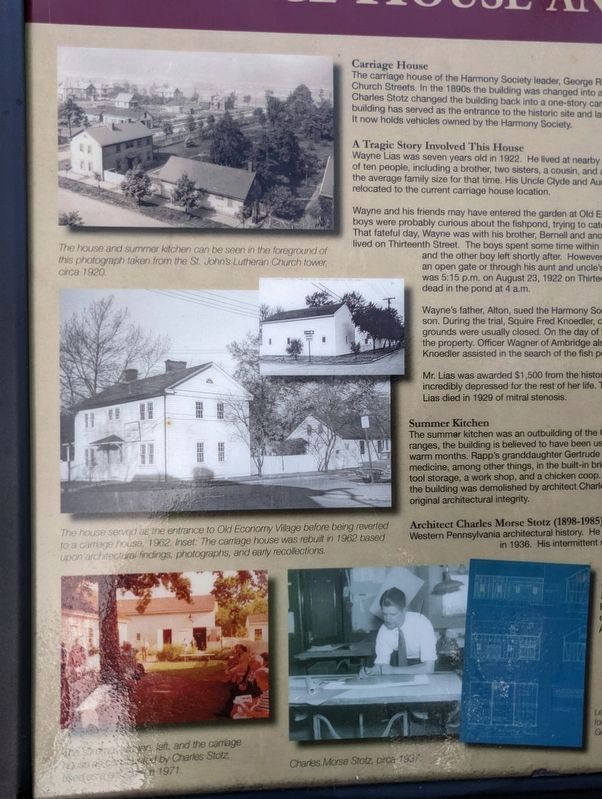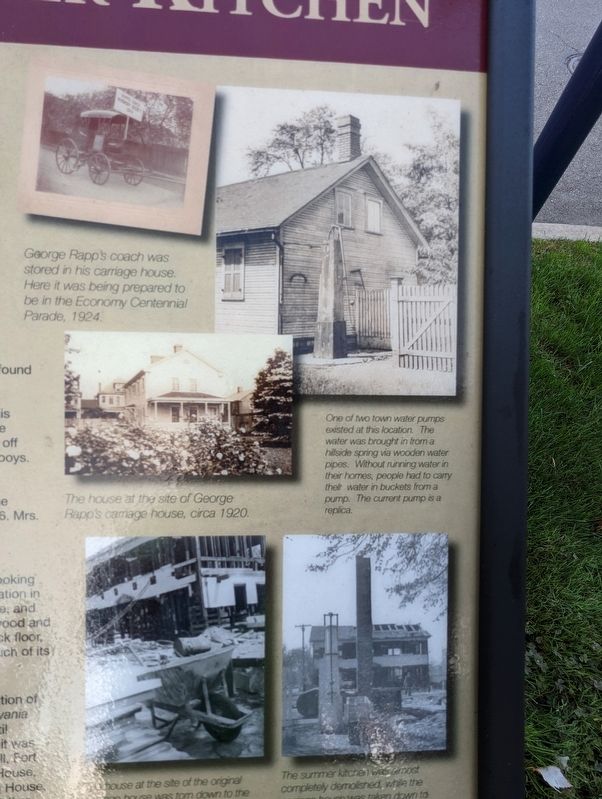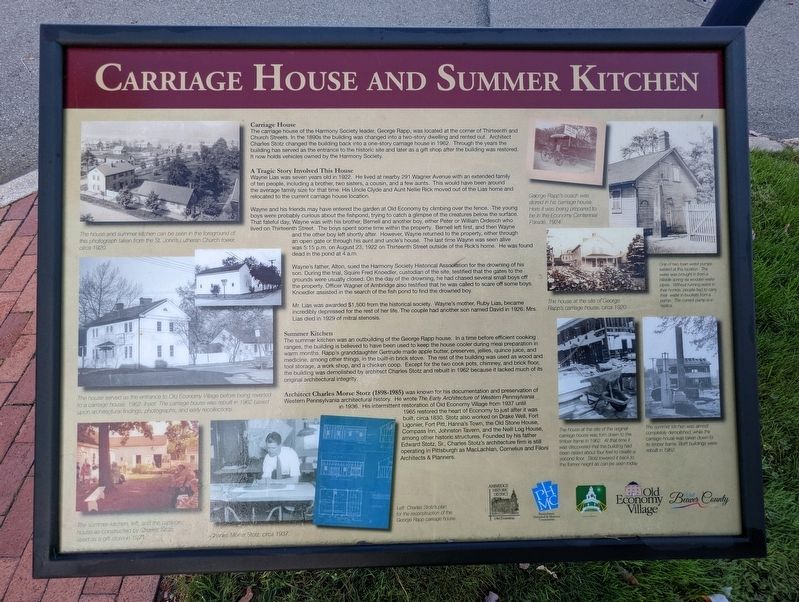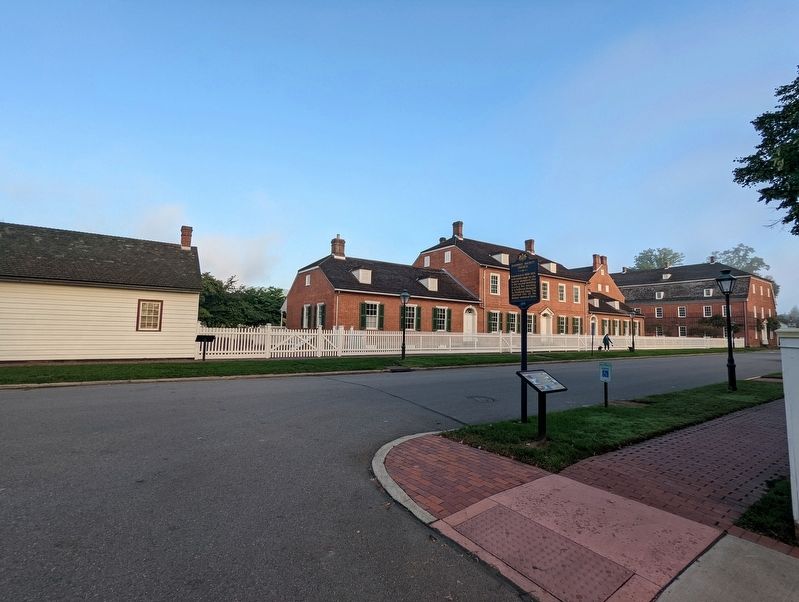Ambridge in Beaver County, Pennsylvania — The American Northeast (Mid-Atlantic)
Carriage House and Summer Kitchen
The carriage house of the Harmony Society leader, George Rapp, was located at the comer of Thirteenth and Church Streets. In the 1890s the building was changed into a two-story dwelling and rented out. Architect Charles Stotz changed the building back into a one-story carriage house in 1962. Through the years the building has served as the entrance to the historic site and later as a gift shop after the building was restored. It now holds vehicles owned by the Harmony Society.
A Tragic Story Involved This House
Wayne Lias was seven years old in 1922. He lived at nearby 291 Wagner Avenue with an extended family of ten people, including a brother, two sisters, a cousin, and a few aunts. This would have been around the average family size for that time. His Uncle Clyde and Aunt Nellie Rick moved out of the Lias home and relocated to the current carriage house location.
Wayne and his friends may have entered the garden at Old Economy by climbing over the fence. The young boys were probably curious about the fishpond, trying to catch a glimpse of the creatures below the surface. That fateful day, Wayne was with his brother, Bernell and another boy, either Peter or William Ordesch who lived on Thirteenth Street. The boys spent some time within the property. Bernell left first, and then Wayne and the other boy left shortly after. However, Wayne returned to the property, either through an open gate or through his aunt and uncle's house. The last time Wayne was seen alive was 5:15 p.m. on August 23, 1922 on Thirteenth Street outside of the Rick's home. He was found dead in the pond at 4 a.m.
Wayne's father, Alton, sued the Harmony Society Historical Association for the drowning of his son. During the trial, Squire Fred Knoedier, custodian of the site, testfied that the gates to the grounds were usually closed. On the day of the drowning, he had chased several small boys off the property. Officer Wagner of Ambridge also testified that he was called to scare off some boys. Knoedler assisted in the search of the fish pond to find the drowned boy.
Mr. Lias was awarded $1,500 from the historical society. Wayne's mother, Ruby Lias, became incredibly depressed for the rest of her life. The couple had another son named David in 1926. Mrs.Lias died in 1929 of mitral stenosis.
Summer Kitchen
The summer kitchen was an outbuilding of the George Rapp house. In a time before efficient cooking ranges, the building is believed to have been used to keep the house cooler during meal preparation in warm months. Rapp's granddaughter Gertrude made apple butter, preserves, jellies, quince juice, and medicine, among other things, in the built-in brick

Photographed By Mike Wintermantel, September 20, 2022
2. Carriage House and Summer Kitchen Marker
Left Side Photos
The house and summer kitchen can be seen in the foreground of this photograph taken from the St. John's Lutheran Church tower, circa 1920.
The house served as the entrance to Old Economy Village before being reverted to a carriage house, 1962. Inset: The carriage house was rebuilt in 1962 based upon architectural findings, photographs, and early recollections.
The summer kitchen, left, and the carriage house as constructed by Charles Stotz, used as a gift store in 1971.
Charles Morse Stotz, circa 1937.
Left: Charles Stotz's plan for the reconstruction of the George Rapp carriage house.
The house and summer kitchen can be seen in the foreground of this photograph taken from the St. John's Lutheran Church tower, circa 1920.
The house served as the entrance to Old Economy Village before being reverted to a carriage house, 1962. Inset: The carriage house was rebuilt in 1962 based upon architectural findings, photographs, and early recollections.
The summer kitchen, left, and the carriage house as constructed by Charles Stotz, used as a gift store in 1971.
Charles Morse Stotz, circa 1937.
Left: Charles Stotz's plan for the reconstruction of the George Rapp carriage house.
Architect Charles More Store (1998-1985) was known for his documentation and preservation of Western Pennsylvania architectural history. He wrote The Early Architecture of Western Pennsylvania in 1936. His intermittent restoration of Old Economy Village from 1937 until 1965 restored the heart of Economy to just after it was built, circa 1830. Stotz also worked on Drake Well, Fort Ligonier, Fort Pitt, Hanna's Town, the Old Stone House, Compass Inn, Johnston Tavern, and the Neill Log House, among other historic structures. Founded by his father Edward Stotz, Sr., Charles Stotz's architecture firm is still operating in Pittsburgh as MacLachlan, Cornelius and Filoni Architects & Planners.
Erected by Ambridge Historic District, Pennsylvania Historical and Museum Commission, Old Economy Village, Visit Beaver County.
Topics and series. This historical marker is listed in this topic list: Notable Buildings. In addition, it is included in the Communal and Utopian Societies series list. A significant historical date for this entry is August 23, 1922.
Location.

Photographed By Mike Wintermantel, September 20, 2022
3. Carriage House and Summer Kitchen Marker
Right Side Photos
George Rapp's coach was stored in his carriage house. Here it was being prepared to be in the Economy Centennial Parade, 1924.
One of two town pumps existed at this location. The waster was brought in from a hillside spring via wooden water pipes. Without running water in their homes, people had to carry their water in buckets from a pump. The current pump is a replica.
The house at the site of George Rapp's carriage house, circa 1920.
The house at the site of the original carriage house was torn down to the timber frame in 1962. At that time it was discovered that the building had been raised about four feet to create a second floor. Stotz lowered it back to the former height as can be seen today.
The summer kitchen was almost completely demolished, while the carriage house was taken down to its timber frame. Both buildings were rebuilt in 1962.
George Rapp's coach was stored in his carriage house. Here it was being prepared to be in the Economy Centennial Parade, 1924.
One of two town pumps existed at this location. The waster was brought in from a hillside spring via wooden water pipes. Without running water in their homes, people had to carry their water in buckets from a pump. The current pump is a replica.
The house at the site of George Rapp's carriage house, circa 1920.
The house at the site of the original carriage house was torn down to the timber frame in 1962. At that time it was discovered that the building had been raised about four feet to create a second floor. Stotz lowered it back to the former height as can be seen today.
The summer kitchen was almost completely demolished, while the carriage house was taken down to its timber frame. Both buildings were rebuilt in 1962.
Other nearby markers. At least 8 other markers are within walking distance of this marker. Harmony Society Church (here, next to this marker); Harmonist Church / St. John's Lutheran Church (a few steps from this marker); Old Economy (within shouting distance of this marker); Greenhouse and Bakery (within shouting distance of this marker); The Harmonist Wool Block (within shouting distance of this marker); Economy Hotel (about 500 feet away, measured in a direct line); Old Economy Memorial (about 500 feet away); Water Pump, Bank, Restaurant, Croatian Club (about 500 feet away). Touch for a list and map of all markers in Ambridge.
Also see . . . Old Economy Village. (Submitted on September 21, 2022, by Mike Wintermantel of Pittsburgh, Pennsylvania.)
Credits. This page was last revised on September 21, 2022. It was originally submitted on September 21, 2022, by Mike Wintermantel of Pittsburgh, Pennsylvania. This page has been viewed 93 times since then and 13 times this year. Photos: 1, 2, 3, 4. submitted on September 21, 2022, by Mike Wintermantel of Pittsburgh, Pennsylvania.

